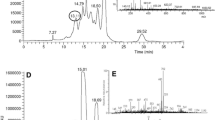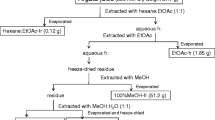Abstract
Henna leaf (Lawsonia inermis), commonly known as Mehndi is cultivated throughout India and is a very popular natural dye to color hand and hair. It is an integral part of indigenous culture, and is also known for its medicinal value. The effect of 200 and 400 mg/kg body weight of 80% ethanolic extract of the fresh leaves of Lawsonia inermis were examined on drug metabolizing phase-I and phase-II enzymes, antioxidant enzymes, glutathione content, lactate dehydrogenase and lipid peroxidation in the liver of 7 weeks old Swiss albino mice. Also anticarcinogenic potential of Henna leaf extract was studied adopting the protocol of benzo(a)pyrene induced forestomach and 7,12 dimethylbenz(a)anthracene (DMBA)-initiated and croton oil-promoted skin papillomagenesis. Our primary findings reveal the ‘duel-acting’ nature of henna leaf as deduced from its potential to induce only the phase-II enzyme activity, associated mainly with carcinogen detoxification in liver of mice and inhibit the phase I enzyme activities. The hepatic glutathione S-transferase and DT-diaphorase specific activities were elevated above basal (p < 0.005) level by Lawsonia inermis extract treatment. With reference to antioxidant enzymes the investigated doses were effective in increasing the hepatic glutathione reductase (GR), superoxide dismutase (SOD) and catalase activities significantly (from p < 0.05 to p < 0.005) at both the dose levels. Reduced glutathione (GSH) measured as non-protein sulphydryl was found to be significantly elevated in liver (p < 0.005) and in all the extrahepatic organs studied (from p < 0.05 to p < 0.005). Among the extrahepatic organs examined (forestomach, kidney and lung) glutathione S-transferase and DT-diaphorase level were increased in a dose independent manner (from p < 0.05 to p < 0.005). Chemopreventive response was measured by the average number of papillomas per mouse (tumor burden) as well as percentage of tumor bearing animals and tumor multiplicity. There was a significant inhibition of tumor burden in both the tumor model systems studied (from p < 0.01 to p < 0.001). Tumor incidence was also reduced by both the doses used in our experiment in both the model systems.
Similar content being viewed by others
References
Kelloff JG, Crowell AJ, Steele EV, Lubet AR, Malone AW, Boone WC, Kopelovich L, Hawk TE, Lieberman R, Lawrence, AJ, Ali I, Viner LJ, Sigman CC: Symposium: Diet, natural products and cancer prevention: Progress and promise. Progress in cancer chemoprevention: Development of diet derived chemopreventive agents. J Nutr 130: 467s-471s, 2000
Jain SK: In: Medicinal Plants. National Book Trust India, 1973, pp 91
Kirtikar KR, Basu BD: In: Lalit Mohan Basu (ed). Indian Medicinal Plants, vol. 2. Allahabad, India, 1956, pp 1077
Satyavati GV, Gupta A, Tandon N: In: Medicinal Plants of India, vol. 2. Indian Council for Medical Research, New Delhi, India, 1987, pp 138
Ahmed S, Rahman A, Alam A, Saleem M, Athar M, Sultana S: Evaluation of the efficacy of Lawsonia alba in the alleviation of carbon tetrachloride-induced oxidative stress. J Ethnopharmacol 69: 157-164, 2000
Ali BH, Bashir AK, Tanira MO: Anti-inflammatory, antipyretic, and analgesic effects of Lawsonia inermis L. (henna) in rats. Pharmacology 51: 356-363, 1995
Anand KK, Singh B, Chand D, Chandan BK: An evaluation of Lawsonia alba extract as hepatoprotective agent. Plant Med 58: 23-25, 1992
Sharma VK: Tuberculostatic activity of henna. (Lawsonia inermis Linn). Tubercle 71: 293-295, 1990
Singh VK, Pandey DK: Fungitoxic studies on bark extract of Lawsonia inermis against ringworm fungi. Hindustan Antibiot Bull 31: 32-35, 1989
Malekzadeh F: Antimicrobial activity of Lawsonia inermis L. Appl Microbiol 16: 663-664, 1968
Henderson JC, Sahraoueit A, Wolf CR: Cytochrome P450 and chemoprevention. Biochem Soc Trans 28: 42-46, 2000
Mates JM: Effects of antioxidant enzymes in the molecular control of reactive oxygen species toxicology. Toxicology 153: 83-104, 2000
Nakamura Y, Ohigashi H, Masuda S, Murakami A, Morimitsu Y, Kawamoto Y, Osawa T, Imagawa M, Uchida K: Redox regulation of glutathione S-transferase induction by benzyl isothiocyanate: correlation of enzyme induction with the formation of reactive oxygen intermediates. Cancer Res 60: 219-225, 2000
Wilkinson JIV, Clapper ML: Detoxification enzymes and chemoprevention. PSEBM 216: 192-200, 1997
Dobashi K, Ghosh B, Orak KJ, Sing AK: Kidney ischemia-reperfusion: Modulation of antioxidant defense. Moll Cell Biochem 205: 1-11, 2000
Chiou T-J, Tzeng W-F: The roles of glutathione and antioxidant enzymes in menadione-induced oxidative stress. Toxicology 154: 75-84, 2000
Omura T, Sato R: The carbon monoxide binding pigment of liver. J Biol Chem 239: 2370-2378, 1964
Omura T, Takasue S: A new method for simultaneous purification of cytochrome b5 and NADPH-cytochrome e reductase from rat liver microsomes. J Biochem 67: 249-257, 1970
Mihara K, Sato R: Partial purification of cytochrome b5 reductase from rabbit liver microsome with detergent and its properties. J Biochem 71: 725-735, 1972
Habig WH, Pabst MJ, Jokoby WB: Glutathione S-transferases — the first step in mercapturic and formation. J Biol Chem 249: 7130-7139, 1974
Ernest L, Danielson L, Ljunggren M: DT-diaphorase-purification from the soluble fraction of rat liver cytoplasm. Biochem Biophys Acta 58: 171-188, 1962
Moron MA, Depierre JW, Mannervick B: Levels of glutathione, glutathione reductase and glutathione S-transferase activities in rat lung and liver. Biochim Biophys Acta 582: 67-78, 1979
Carberg I, Mannervik B: Glutathione reductase In: Methods in Enzymology, vol. 113. Academic Press, New York, 1985, pp 484-490
Paglia DE, Valentine WM: Studies on the quantitative and qualitative characterization of erythrocyte glutathione peroxidase. J Lab Clin Med 70: 158-169, 1967
Aebi H: Catalase in vitro. In: S.P. Colowick, N.O. Kaplan (eds). Methods in Enzymology, vol. 105. Academic Press, New York, 1984, pp 121-126
Marklund S, Marklund G: Involvement of superoxide anion radical in autooxidation of pyragallol and a convenient assay for superoxide dismutase. Eur J Biochem 47: 469-474, 1974
Varshney R, Kale RK: Effects of calmodulin antagonists on radiation induced lipid peroxidation in microsomes. Int J Rad Biol 58: 733-743, 1990
Bergmeyer HU, Bernt E: In: Methods of Enzymatic Analysis, vol II. Verlag Academic Press, 1971, pp 5574-5579
Lowry OH, Rosenbrough NJ, Farr A, Randall RJ: Protein measurement with the Folin phenol reagent. J Biol Chem 193: 265-275, 1951
Yasukawa K, Yu S, Yamanouchi S, Takido M, Akihisa T, Tamura T: Some lupene-type triterpens inhibit tumor promotion by 12-0-tetra-decanoylphorbol-13-acetate: In two-stage carcinogenesis in mouse skin. Phytomedicine 4: 309-313, 1995
Azuine MA, Bhide SV: Chemopreventive effect of turmeric against stomach and skin carcinogenesis in Swiss mice. Nutr Cancer 17: 77-83, 1992
Wattenberg LW, Coccia JB, Lam LKT: Inhibitory effects of phenolic compounds on benzo(a)pyrene induced neoplasia. Cancer Res 40: 2820-2823, 1980
Belinsky N, Jaiswal AK: NAD(P)H:quinone oxidoreductase 1 (DT-diaphorase) expression in normal and tumor tissues. Cancer Metastasis Rev 12: 103-117, 1993
Chemoprevention working group: Prevention of cancer in the next millenium: Report of the chemoprevention working group to the American association for cancer research. Cancer Res 59: 4743-4758, 1999
Hakama M: Chemoprevention of cancer. Acta Oncol 37: 227-230, 1998
Sporn MB, Suh N: Chemoprevention of cancer. Carcinogenesis 21: 525-530, 2000
Kellen AJ: Chemoprevention of cancer: An ongoing saga. In vivo 13: 423-426, 1999
Fiander H, Schneider H: Dietary orthophenols that induce glutathione S-transferase and increase the resistance of cells to hydrogen peroxide are potential cancer chemopreventives that act by two mechanisms: The alleviation of oxidative stress and the detoxification of mutagenic xenobiotics. Cancer Lett 156: 117-124, 2000
Ngo EO, Nutter LM: Status of glutathione and glutathione-metabolising enzymes in menadione-resistance human cancer cells. Biochem Pharmacol 20: 421-424, 1994
Thor H, Smith TM, Hartzell P, Bellomo G, Jewell AS, Orrenius S: The metabolism of menadione (2-methyl-1,4-naphthoquinone) by isolated hepatocytes. J Biol Chem 29: 12419-12425, 1983
Conklin AK: Dietary antioxidants during cancer chemotherapy: Impact on chemotherapeutic effectiveness and development of side effects. Nutr Cancer 37: 1-18, 2000
Bagchi D, Bagchi M, Stohs JS, Das KD, Ray DS, Kuszynski AC, Joshi SS, Pruess GH: Free radicals and grape seed proanthocyanidin extract: Importance in human health and disease prevention. Toxicology 148: 187-197, 2000
Mayer C, Schmezer P, Freese R, Mutanen M, Hietanen E, Obe G, Base S, Bartsch H: Lipid peroxidation status, somatic mutations and micronuclei in peripheral lymphocytes: A case observation on a possible interrelationship. Cancer Lett 152: 169-173, 2000
Li S, Yan T, Yang QJ, Oberley DT, Oberley WL: The role of cellular glutathione peroxidase redox regulation in the suppression of tumor cell growth by manganese superoxide dismutase. Cancer Res 60: 3927-3939, 2000
Izawa S, Inoue Y, Kimura A: Importance of catalase in the adaptive response to hydrogen peroxide: Analysis of acatalasamic Saccharomyces cerevisiae. Biochem J 320: 61-67, 1996
Tzeng WF, Chiou TJ, Wang CP, Lee JL, Chen YH: Cellular thiols as a determinant of responsiveness to menadione in cardiomyocytes. J Mol Cell Cardiol 26: 889-897, 1994
Reed DJ: Glutathione: toxicological implications. Annu Rev Pharmacol Toxicol 30: 603-631, 1990
Jernstrom B, Morgenstern R, Moldeus P: Protective role of glutathione, thiols and analogues in mutagenesis and carcinogenesis. In: G. Bronzetti et al. (eds). Antimutagenesis and Anticarcinogenesis Mechanisms III. Plenum Press, New York, 1993, pp 137-147
Lawrence JM: Oxyradicals and DNA damage. Carcinogenesis 21: 361-370, 2000
Mates JM, Sanchez-Jimenez F: Antioxidant enzymes and their implications in pathophysiologic processes. Front Biosci 4: 339-345, 1999
Bayney RM, Rodkey JA, Bennett CD, Lu AY, Pickett CB: Rat liver NAD(P)H:quinone reductase nucleotide sequence analysis of a quinone reductase cDNA clone and prediction of the amino acid sequence of the corresponding protein. J Biol Chem 262: 572-575, 1987
Benson AM, Hunkeler MJ, Talalay P: Increase of NAD(P)H:quinone reductase by dietary antioxidants: Possible role in protection against carcinogenesis and toxicity. Proc Natl Acad Sci USA 77: 5216-5220, 1980
Begleiter A, Leith KM, Curphey JT, Doherty PG: Induction of DT-diaphorase in cancer chemoprevention and chemotherapy. Oncology Res 9: 371-382, 1997
Author information
Authors and Affiliations
Rights and permissions
About this article
Cite this article
Dasgupta, T., Rao, A. & Yadava, P. Modulatory effect of Henna leaf (Lawsonia inermis) on drug metabolising phase I and phase II enzymes, antioxidant enzymes, lipid peroxidation and chemically induced skin and forestomach papillomagenesis in mice. Mol Cell Biochem 245, 11–22 (2003). https://doi.org/10.1023/A:1022853007710
Issue Date:
DOI: https://doi.org/10.1023/A:1022853007710




